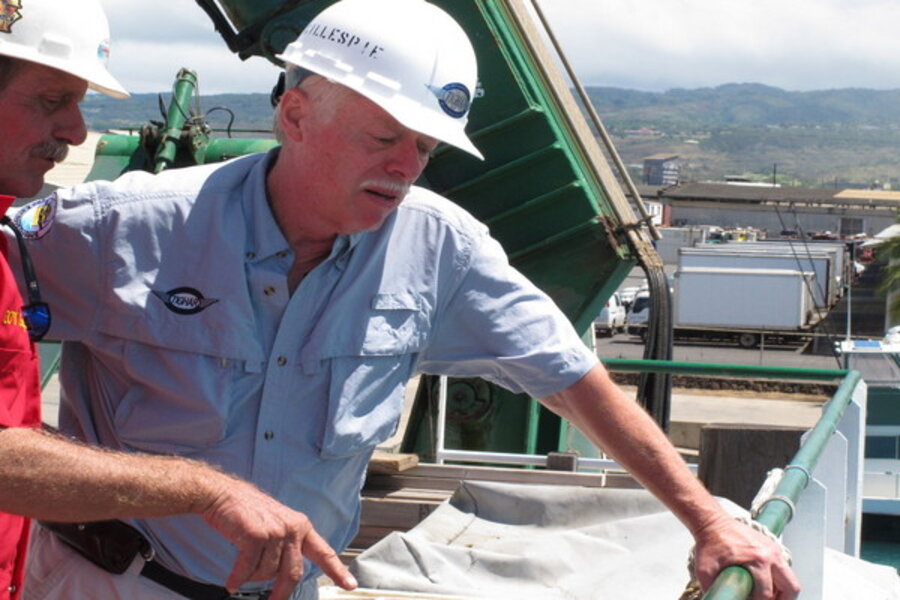Will researchers solve the mystery of Amelia Earhart's disappearance?
Loading...
| HONOLULU
Seeking to chronicle Amelia Earhart's fate 75 years after she disappeared over the Pacific, researchers prepared on Monday to look for wreckage of her airplane near a remote island where they believe the famed U.S. aviator died as a castaway.
Organizers hope the expedition will conclusively solve one of the most enduring mysteries of the 20th century - what became of Earhart after she vanished during an attempt to become the first pilot, man or woman, to circle the globe around the equator.
A recent flurry of clues point to the possibility that Earhart and her navigator, Fred Noonan, ended up marooned on the tiny uninhabited island of Nikumaroro, part of the Pacific archipelago Republic of Kiribati."
The public wants evidence, a smoking gun, that this is the place where Amelia Earhart's journey ended," said Richard Gillespie, executive director of The International Group for Historic Aircraft Recovery (TIGHAR). "That smoking gun is Earhart's plane.
"The group's research team had planned to set off by boat on Monday from Hawaii on a 1,800-mile voyage to Nikumaroro accompanied by the technicians from a U.S. Navy contractor called Phoenix International who recovered "black-box" flight-data recorders from an Air France crash from the floor of the Atlantic last year.
But the departure was postponed for a day, until Tuesday, because of a delay in the arrival of a Kiribati customs official who is to accompany the expedition, said Stephanie Buttrill, a spokeswoman for the group. The team will spend 10 days at the search site, plus 16 days at sea traveling to and from the island.
Previous missions to Nikumaroro have unearthed tantalizing evidence that Earhart was there, including a cosmetic bottle from the 1930s that appeared to be jar of a once-popular brand of anti-freckle cream.
Also found were a clothing zipper from the '30s, pieces of a woman's compact, a bottle of hand lotion, parts of a woman's shoe and a man's shoe, a bone-handled pocket knife of the type Earhart carried and human bone fragments.
"We've found artifacts of an American woman castaway from the 1930s, but we haven't found anything with her name on it," said Gillespie. "We've tried to get contact DNA from things that were touched, and it didn't work. The environment was too destructive. The recovered bone samples were too small. The logical thing is the airplane."
Flying into the Unknown
Earhart and Noonan were last seen taking off in her twin-engine Lockheed Electra on July 2, 1937, from Papua New Guinea en route to tiny Howland Island, some 2,500 miles away in the central Pacific. Radio contact with her plane was lost hours later after she reported running low on fuel.
A massive air-and-sea search, the most extensive such U.S. operation at that time, was unsuccessful. Earhart's plane was presumed to have gone down, but it has never been known whether she survived, and if so, for how long.
TIGHAR researchers theorize that Earhart and Noonan made an emergency landing on Nikumaroro, then called Gardner Island, about 400 miles southeast of their destination on Howland.
Gillespie believes that within of days of its landing, the plane was washed over the island's edge by rising tides and surf, and was pulled down the reef slope into as-yet unexplored depths.
A recently enhanced 1937 photograph, taken three months after Earhart's disappearance by a British officer, shows what is now thought to be a detached landing gear assembly on the island's Western reef.
It is the same location where TIGHAR had hypothesized the plane might have landed and will be the geographic starting point in their underwater search.
Using underwater robotic submarines equipped with sonar, researchers will first map the sea floor, then probe the depths for objects that might be pieces of the aircraft.
If they find something promising, a third, remote-controlled submersible vehicle with camera, lights and a robot arm will attempt to explore the object up close.
But Gillespie cautioned that the conditions for such a search were less than ideal, explaining that the sonar probe works best over a flat, sandy bottom, rather than the craggy, reef slope the team expects to encounter at the site.
After 24 years of working on the Earhart case, Gillespie said he accepts that previous hypotheses have been disproved, and this seemingly promising one could be as well.
"That's scary. What if you look there and you don't find it? It might mean you're wrong. Or after 75 years of dynamic, destructive ocean activity, we could be absolutely right and not find anything," he said.
"It's hard not to see the parallel with Amelia's trip. You prepare the best you can and recognize, well, you're taking a risk. We're out to prove the case if it can be proven."
(Reporting by Malia Mattoch McManus; Editing by Steve Gorman, Cynthia Johnston and Cynthia Osterman)







